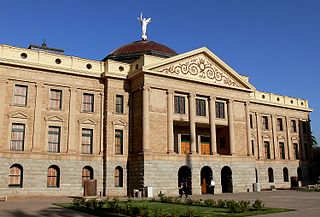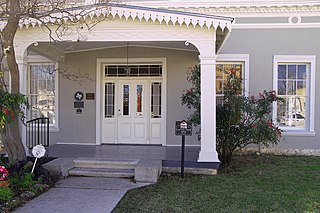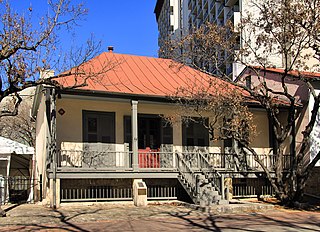
James Riely Gordon was an architect who practiced in San Antonio until 1902 and then in New York City, where he gained national recognition. J. Riely Gordon is best known for his landmark county courthouses, in particular those in Texas. Working during the state's "Golden Age" (1883–1898) of courthouse construction, Gordon saw 18 of his designs erected from 1885 to 1901; today 12 remain.

This is a list of the National Register of Historic Places listings in Bexar County, Texas.

The Capt. Charles Schreiner Mansion is located in Kerrville in the U.S. state of Texas. It was added to the National Register of Historic Places listings in Kerr County, Texas in 1975. It was designated a Recorded Texas Historic Landmark in 1962. The mansion is currently the home of the Hill Country Museum. In 1984, Mrs. E. C. Parker was awarded a Jefferson Davis Certificate of Meritorious Service for Preservation and Restoration, in honor of her work in converting the mansion into a museum.

The 1911 Asher and Mary Isabelle Richardson House is located on U.S. Highway 83 in the Dimmit County community of Asherton in the U.S. state of Texas. The southeast-facing home is also known as Bel-Asher, deriving the "Bel" from "Isabelle". It was added to the National Register of Historic Places listings in Dimmit County, Texas in 1988. It was designated a Recorded Texas Historic Landmark in 1980.

Alfred Giles was a British architect who emigrated to the United States in 1873 at the age of 20. Many of the private homes and public buildings designed by Giles are on the National Register of Historic Places and have been designated Recorded Texas Historic Landmarks. Based in San Antonio, his buildings can be found predominantly in south Texas and northern Mexico. Giles is credited with "a profound influence on architecture in San Antonio."

The Morris Ranch Schoolhouse is a ranch school located on Morris Ranch Road 2093, 8.5 miles (13.7 km) southwest of Fredericksburg in Gillespie County, in the U.S. state of Texas. It was placed on the National Register of Historic Places in 1983, and was designated a Recorded Texas Historic Landmark in 1981. Designed by Alfred Giles, who also designed the 1882 Fredericksburg Memorial Library, the schoolhouse was built in 1893. Winning thoroughbred trainer Max Hirsch began his career on Morris Ranch and attended classes in the schoolhouse.
Carl Wilhelm August Groos House or Carl W. A. Groos House may refer to:

The Carl W. A. Groos House is located in the city of New Braunfels, county of Comal, in the U.S. state of Texas. It was added to the National Register of Historic Places listings in Comal County, Texas in 2000, and designated a Recorded Texas Historic Landmark in 1968. Groos occupied this house for approximately one year. He moved to San Antonio, and in 1880 had architect Alfred Giles design his home which became known as the Carl Wilhelm August Groos House. Originally owned by one of the early German emigrants to New Braunfels, the house has also remained in the hands of descendants of the early German settlers. Diplomat Bob Krueger used the building for his business office and renovated it in 1999.

The Guenther House is a restaurant, museum and store located at 205 E. Guenther Street in the King William neighborhood of the Bexar County city of San Antonio in the U.S. state of Texas. Currently operated by C. H. Guenther and Son. Inc., the home was originally built as a private residence in 1859 by Pioneer Flour Mills founder Carl Hilmar Guenther. It was listed on the National Register of Historic Places listings in Bexar County, Texas on October 11, 1990.

Casa Navarro is a historic site in San Antonio, Bexar County, in the U.S. state of Texas. The original house complex was the residence of Texas patriot José Antonio Navarro (1795–1871), a rancher, merchant, leading advocate for Tejano rights, and one of only two native-born Texans to sign the Texas Declaration of Independence. Navarro first bought the property, about 1.5 acres, in 1832. The limestone, caliche block, and adobe structures were built c. 1832–1855, and Navarro moved onto the property soon after.

The Edward Steves Homestead is located in the Bexar County city of San Antonio in the U.S. state of Texas. It was designed by architect Alfred Giles and designated a Recorded Texas Historic Landmark. The main house was donated to the San Antonio Conservation Society in 1952. The organization completely restored the main house as a museum and now conducts daily tours. The complete homestead property consists of four individual structures: the main house museum, the carriage house, the river house, and the servants' quarters. It is listed on the National Register of Historic Places listings in Bexar County, Texas, as a contributing structure of the King William Historic District.

The Jeremiah Dashiell House is located in the Bexar County city of San Antonio in the U.S. state of Texas. Also known as Casa Villita, it was designated a Recorded Texas Historic Landmark under that name in 1962. It is listed on the National Register of Historic Places listings in Bexar County, Texas as a contributing structure of the La Villita Historic District.

The Anton Wulff House is located in the San Antonio, Bexar County, Texas. The house has been designated a Recorded Texas Historic Landmark; and is listed on the National Register of Historic Places listings in Bexar County, Texas (NRHP). Wulff House was the headquarters of the San Antonio Conservation Society from 1975 to 2022. The original occupant who commissioned its construction was German immigrant and businessman Anton Wulff. He was a city alderman, San Antonio's first park commissioner, and the man who designed the layout of the city's Alamo Plaza.

The Yturri–Edmunds Historic Site is an historic site in San Antonio, Texas. The house is listed on the National Register of Historic Places listings in Bexar County, Texas. The homestead and mill were designated a Recorded Texas Historic Landmark in 1966.

Acequia Madre de Valero is an 18th-century agricultural irrigation canal built by the Spanish and located in the Bexar County city of San Antonio in the U.S. state of Texas. When Martín de Alarcón founded San Antonio for Spain by establishing San Antonio de Valero Mission in 1718, Franciscan priest Antonio de Olivares and the Payaya and Pastia peoples, dug Acequia Madre de Valero by hand. It was vital to the missions to be able to divert and control water from the San Antonio River, in order to grow crops and to supply water to the people in the area. This particular acequia was the beginning of a much wider irrigation system. Acequia Madre de Valero ran from the area currently known as Brackenridge Park southward to what is now Hemisfair Plaza and South Alamo Street. Part of it that is not viewable by the public runs beneath the Menger Hotel. The acequia was restored in 1968 and that same year was designated a Recorded Texas Historic Landmark.

The Johann and Anna Heidgen House is located in the Bexar County city of San Antonio in the U.S. state of Texas. It is listed on the National Register of Historic Places listings in Bexar County, Texas. The structure was designated a Recorded Texas Historic Landmark in 2003. It is also known as the Heidgen-Zilker House. The house was built circa 1882 and has been used for a variety of purposes, including as a residence, as a youth organization facility, and at one time as a restaurant. It currently serves as the office of a San Antonio attorney.

The Norton–Polk–Mathis House, also known Villa Finale, is a historic house in San Antonio, Texas, United States.

The O. Henry House Museum is a historic house museum located in San Antonio, Texas. It is named for the American writer, William Sydney Porter, better known by his pen name O. Henry, who lived in the house in 1885.
The King William Historic District of San Antonio, Texas was listed on the National Register of Historic Places listings in Bexar County, Texas on January 20, 1972. The area was originally used as farm acreage by the Spanish priests of the Misión San Antonio de Valero, and eventually parceled off for the local indigenous peoples of the area. In addition to residential homes, the district also includes the King William Park and Bandstand originally built in 1892 on the arsenal grounds, and later moved to its current location. Other features are the Upper Mill Park, the King William River Walk, and the Johnson Street pedestrian bridge.




















